How To Reduce Eye Strain While Playing Video Games
Key points
Disclaimer
This information is for educational purposes only and is not intended to supercede the advice of your doctor. Esports Healthcare disclaims any liability for the decisions you make based on this information.
The information contained on this website does non plant, nor does it imply, doctor-patient relationship. Esports Healthcare does not offer this information for diagnostic purposes. A diagnosis must not be assumed based on the information provided.
What is eye strain?
Eye strain is a condition that occurs after long hours of strenuous activity for the muscles in and effectually your eyes. For gamers, this will occur later prolonged screen time which includes short, rapid movements of the eyes and focus only on the monitor(s) in front of you.
Eye strain is exactly what information technology sounds like. After staring at your screen for hours on end, the muscles in and around your eyes get irritated or strained. At that place are muscles on the outside of your eyes for center movement, and there are muscles inside your eyes to contract or relax the lens and pupil. Each of these muscles have the potential to become strained.
Pertinent anatomy
Information technology'south important to know some bones eye anatomy to understand eye strain. As previously mentioned, in that location are 2 groups of muscles for your eyes.
The starting time grouping of muscles are located outside your eyeball and move your eyes in their sockets. These are called extraocular muscles.
The 2d group of muscles are located inside your eyeball and contract or relax the lens and pupil. These are called intraocular muscles.
Extraocular muscles
There are 6 extraocular muscles that create all the movements of the optics within the centre sockets. 4 of these muscles are for basic, linear motility of the eyeballs:
- Superior rectus: elevation of your eyes; looking upwards
- Inferior rectus: depression of your eyes; looking downwards
- Medial rectus: adduction of your eyes; looking inward
- Lateral rectus: abduction of your eyes; looking outward
There are two additional muscles that create centre movement within the eye socket: superior oblique and inferior oblique. Both muscles perform an action called torsion, or the action of rotating your eyes inside your eye sockets to keep them flush with the ground. This activity allows you to rotate your caput slightly, in either direction, without irresolute your perspective.
The superior oblique also creates low and abduction, or the motion of looking downwards and outward. The inferior oblique does elevation and abduction, or the motion of looking upwards and outward.
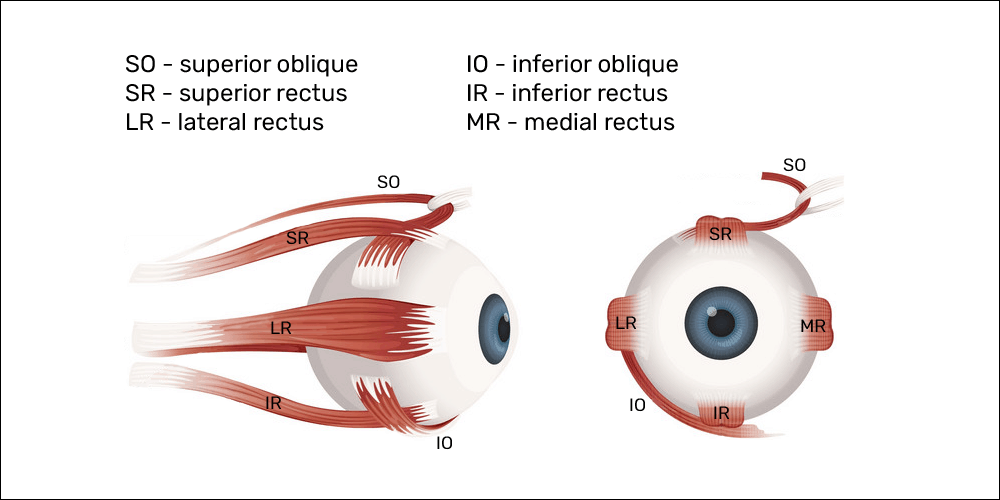
Levator palpebrae superioris
Two other muscles involved in middle strain are those that open and shut your eye lids. The muscle that opens your centre lids is called the levator palpebrae superioris. During long hours of gaming, your blinking rate is reduced, which means the levator palpebrae superioris muscles are agile for longer durations of time—thus leading to strain.
Keeping your eyes open for long periods of time may reduce the activation of the orbicularis oculi if you lot keep your optics fully open. The bones office of this musculus is to close your eyelids.
Withal, some other activity of this musculus action can exist described as narrowing the palpebral discontinuity, which is a fancy phrase for the activeness of squinting. This action can go more common if the screen brightness is too high, if you lot are experiencing the condition known as dry eyes, or if your vision is not properly corrected (e.g., spectacles or contact lens prescription).
If you recognize that yous are squinting during gaming sessions, we suggest you visit an heart medico to accost possible causes including the demand for vision correction.
Intraocular muscles
There are 3 intraocular muscles that contract or relax the lens or the pupil. These muscles can be separated into 2 groups:
Ciliary muscles
Theciliary muscles are involved in the contraction and relaxation of the lens to let focus on near or far objects.
- Near focus: ciliary muscles contract and the lens becomes round
- Far focus: ciliary muscles relax and the lens becomes flatter
This distinction is incredibly important considering most people's gaming monitors are inside 30 inches from their confront. Therefore, the ciliary muscles will be active for the entire duration of the gaming session, thus leading to more rapid eye strain.
Iris muscles
Theradial muscles of the iris volition cause dilation or widening of the educatee, and theround (sphincter) muscles of the iris will cause constriction of the pupil.
These muscles volition work to change the corporeality of light that enters the eye. When there is insufficient or dim lighting, the pupils will dilate; when there is bright light, the pupils will constrict.
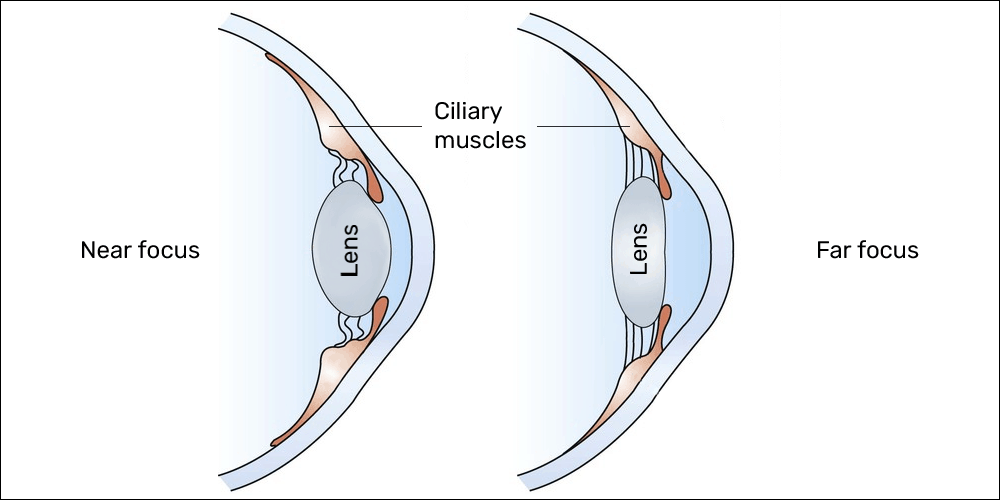
Pathophysiology
Centre strain in gamers occurs when the muscles of the eyes become overworked due to playing video games. This is a combination of the limited surface area infinite where you focus your gaze and the static depth of focus.
Limited expanse of gaze
While gaming, most people use a monitor that'southward in the range of 20-24 inches. During game play, your eyes volition nigh always stay within the frame of the monitor.
Exceptions include streaming or other activities where you have a dual monitor and your attention goes off screen, but the majority of your gaze will be within your gaming monitor.
In improver to the small area, many games will require your optics to move rapidly around the screen. Whether searching for the enemy or tracking your character'south movements, your optics will often motion rapidly in this small space.
These rapid, minor, repetitive movements can cause strain to the extraocular muscles.
Static focal distance
While gaming, your monitor will, hopefully, be approximately 24 inches from your face (check your setup!). During game play, your optics will just always focus to this altitude—unless, of course, you move your body or monitor closer or further abroad.
Exceptions include streaming or other activities where you have a dual monitor and your attention goes off screen; nonetheless, your focal distance volition still exist relatively close.
Because your focal altitude is static, or fixed, approximately 24 inches from your confront, the ciliary muscles will hold a static wrinkle. Remember, the ciliary muscles are active to curve the lens for near focus.
The ciliary muscles volition maintain this wrinkle for the duration of your game play, which volition lead to eye strain during long gaming hours.

Signs and symptoms
The most mutual symptoms of eye strain include irritation of the optics:
- Fatigue
- Pain in eyeballs
- Pain in the eye sockets
- Blurred vision
- Headaches
- Occasional double vision
Some other mutual symptom of eye strain is dry eyes, which is more than just lack of wet on the surface of your eyeball. Symptoms may include:
- Stinging or called-for
- Sensitivity to light
- Redness of the sclera (the white part of your eyeballs)
- Straining nighttime vision
- Blurred vision
Mutual mechanism of injury
The mechanism of eye strain in gamers is partially explained in Pathophysiology above.
- Express area of gaze
- Static focal distance
Moving your eyes quickly and quickly in a pocket-size infinite combined with a short, static focal distance leads to eye strain, but there is also one more than business with gaming: blinking!
Blinking
Blinking provides hydration to the eyes using moisture from tears and mucous secretions. In a normal, resting country, the average number of blinks per infinitesimal is around 20.
However, while gaming, this number may exist less than one-half. During the hypervigilance of intense gameplay, you may only blink five-x times per minute, leaving your eyes at adventure for becoming excessively dry.
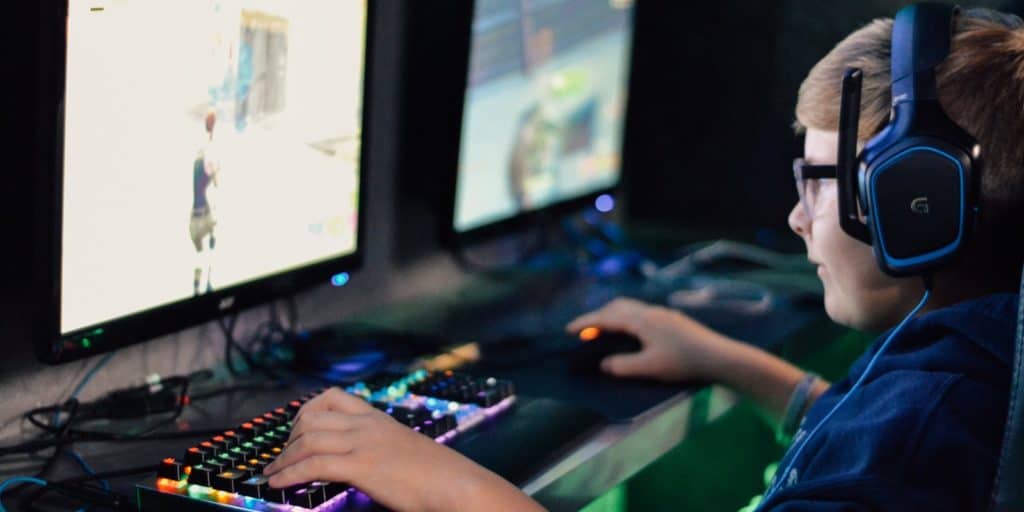
Blueish lite concerns
Another mutual concern is how blue lights from LED screens and monitors may affect your eyes. To learn more about these effects, read our post on blue light which explains everything you demand to know about bluish light including how you can protect yourself.
Prevention and rehabilitation
Prevention of dry eyes and eye strain is pretty straight forward. In brusque, take breaks!
- Every 5-10 minutes , blink! Blink your eyes and agree them shut for 3 seconds, 5 times total. This will allow the moisturizing fungus of your eyelids to cover and protect the outer surface of your eyes.
- Every 20-xxx minutes , take a 5-minute break to look away from your screen. Since the ciliary muscles relax during far focus, you'll want to look at something far abroad. If you're able to, await outside; if not, look as far equally you tin inside your dwelling house.
- Every 30-60 minutes , perform smooth pursuit OR target gaze (listed below) to assist reduce the strain on the extraocular muscles.
Lastly, don't forget the power of a adept night'due south slumber. If y'all're constantly grinding to become the best, you will most certainly experience heart strain, and sleep is your best tool for recovery to continue gaming tomorrow.
Middle exercises
These three exercises are included in our Gamer Warm-up. We propose performing the unabridged Gamer Warm-up prior to each gaming session.
Near-to-far focus
- Agree an object (for instance, a pencil or your thumb) in front of your nose, approximately 12 inches away from your face
- Hold the object in forepart of a background target at to the lowest degree 20 anxiety away (for example, the wall of your room or any object exterior your window)
- First, focus your eyes on the object (the pencil eraser or your pollex blast). And then, focus your eyes on the background target
- Repeat pace three for a full of ten (10) repetition
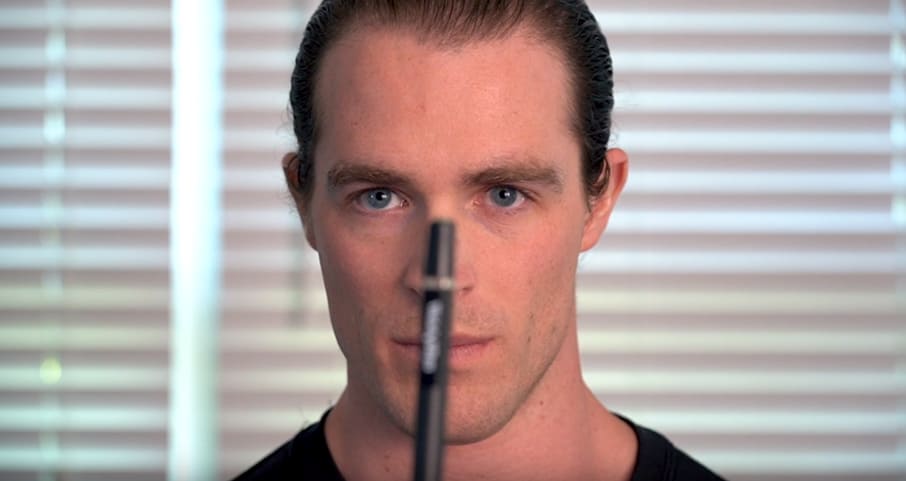
Smooth pursuit
- Hold an object (for example, a pencil or your thumb) in forepart of your nose, approximately 12 inches away from your face up
- Without moving your head, slowly movement the object dorsum and forth, up and downward, or diagonally
- Move the object in H-pattern and/or an X-blueprint, moving information technology as far as your eyes can gaze without the need to motion your caput.
- Endeavor to reach all four corners of your gaze
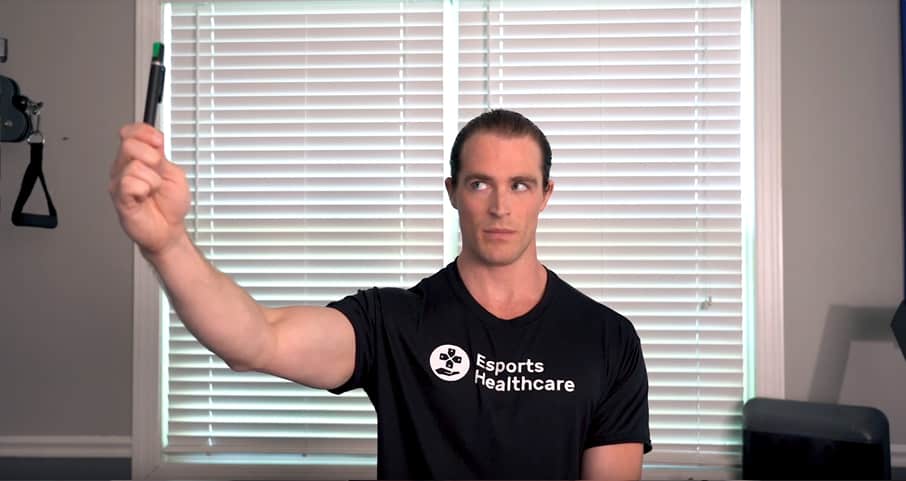
Target gaze
- Choose whatever focal point straight in front of your face; for instance, a bespeak on your computer screen
- Without moving your caput, look directly upward equally far every bit y'all tin can, as if y'all were looking at 12 on a clock. Then, return your gaze to the starting signal in forepart of yous
- Echo this gaze pattern for each of the remaining xi numbered positions on a clock in a clockwise blueprint
- Echo steps ii and iii in a counter-clockwise pattern, beginning once again with 12 o'clock

References
How To Reduce Eye Strain While Playing Video Games,
Source: https://esportshealthcare.com/eye-strain-in-gamers/
Posted by: leakenatithem.blogspot.com


0 Response to "How To Reduce Eye Strain While Playing Video Games"
Post a Comment